
|   |

|   |
NCPA's Mudra dance festival - Dr. Sunil Kothari e-mail: sunilkothari1933@gmail.com April 30, 2014 From 24th till 30th April, NCPA organized Mudra dance festival at Experimental Theatre, conceived by Swapnokalpa, the Director for Dance at NCPA, on the theme of motherhood. On the opening night, Mumbai based Odissi exponent Jhelum Paranjape presented a programme titled 'What is Motherhood?' With her son Bunkim, who is a fresh voice in Indian music with a style which centres round pop, drawing equally from Rock, Folk, Funk and Bollywood, Jhelum succeeded in revealing several layers of relationship between mother and son through classical Odissi style, at times using free dance form, appropriate to the content of the song and sentiments. 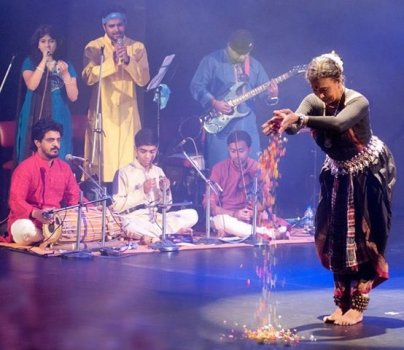
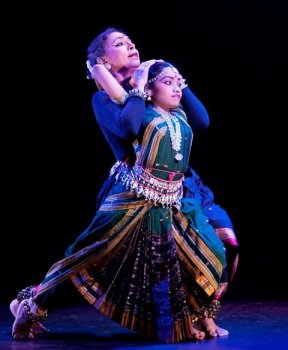
Jhelum Paranjape
This was for the first time that Bunkim was singing for his mother. It
was indeed interesting to see Bunkim as a song writer, composer, singer,
singing for Jhelum. It was a poignant moment. Jhelum had recently lost
her mother Sudha Varde, a distinguished woman, active politician,
social worker and had also studied dance for joy and not to be a
professional dancer. Jhelum had not planned to be a dancer. Brilliant
academician with deep interest in Mathematics, when she saw Guru
Kelucharan Mohapatra's Odissi, she fell under the spell of Guruji's
devotion. Though agnostic, she somehow could see in Guruji the sincere
belief in god. Hers is an interesting story. Her feelings for her mother
are expressed in her article in narthaki.com. Jhelum paid tribute to mother symbolically to India and her own mother with Vande Mataram, followed by Braj ku chora ashichhi (go to sleep, my dear child, a thief has come to Braj, he shall take you away) choreographed by Guru Kelucharan Mohapatra, to depict childhood when the son does not go to sleep. Then it was fascinating to listen to Bunkim's commentary and his singing narrating when he was sent away to hostel, his loneliness, which as mother only she was able to understand. In the Hindi song, he cried: Main kabhi badalta nahi, par andhere se darata hun main, teri parava karatahun main, tujhe sab pata hai Maa (I do not change, O Mother, but yes, I am afraid of darkness, I care for you, Maa. You know everything). Mother knew that her son was afraid of leaving her, but also he wanted to soar in the sky! Quite delicate emotions, listening to it, I had a catch in my throat. Bunkim was in great form, belting out songs, even reminiscent of Bollywood song in Punjabi language, confiding to mother about the girl he loved et al. Emotions of a son killed in war, overprotective when child was young and growing up, were explored by Jhelum. Bunkim composed in Chhayanat, a pallavi which Jhelum choreographed. Some of us felt that if such songs and themes were presented with music as Bunkim composed, the young generation would form new audience for classical dance. There was no mishmash when traditional and non-traditional dance forms were employed. We loved relishing shared and familiar emotions which had instant appeal. Bravo, Jhelum! 'The Moving Roots-Taa' by Padma Sharma, her daughter Gauri Sharma Tripathi and granddaughter Tarini Tripathi explored Kathak form. I missed their presentation. I am familiar with their work as I had seen three of them performing during Mohanrao Kallianpurkar's centenary programme at Pune. Whereas Padma has old world charm, having mastered Lucknow gharana from no less a guru than legendary Lachhu Maharaj, Gauri has the advantage of mastering the technique directly from her mother Padma and then living in London exposed to various international art forms, choreographing dance productions, expanding her horizons, and teaching young dancers in London, including her daughter Tarini. It was an excellent idea to put on one stage grandmother, mother and granddaughter -three generations. I also missed the Q and A after the two presentations conducted by dancer Lata Surendra. 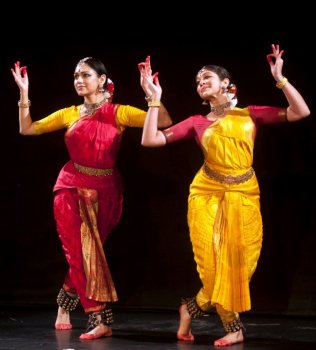
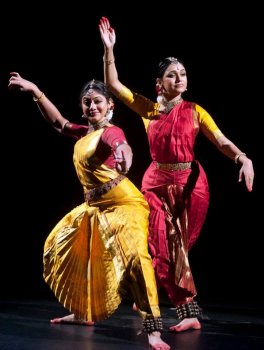
Rama Vaidyanathan and Dakshina
Next day, Rama Vaidyanathan and her daughter Dakshina presented 'Dwita-
Duality of Life.' Rama has in recent years carved a niche for herself
joining the league of top ranking dancers Alarmel Valli, Malavika
Sarukkai, Priyadarsini Govind and Urmila Satyanarayanan .Each one of
them has her individual signature style. Rama and Dakshina danced the
first number together, extolling the benign and ferocious nature of
Devi, two aspects, duality which exists in every walk of our lives. They
impressed the audience with their excellent technique in Bharatanatyam.
There was an implicit suggestion that the mother symbolizes the
'present' and the daughter the 'future.' Both seemed to have taken up
the challenge to exist in parallel streams, without losing their
individual identity and yet they complimented each other.Well planned, they also presented solo numbers. Rama in Pannagendra shayana, took a variety of postures showing the Lord reclining on serpent couch. The way she placed two arms behind her neck with an incline of the body, at times standing still like a rock, the music fading, Rama slowly bending, sitting on the floor awash with red light, ah, the images linger long in my mind. Rama delineates the content imaginatively, the visuals further enhanced by a quicksilver quality of her dance, a certain quick jump, and covering of the stage; these touches stand out in her dancing. And there is an inner stillness in her abhinaya. While the strength of the quality of her movements charms her audience, the abhinaya with subtle touches leaves an impact. Dakshina's Ardhanarishwara showed her in her element. Delineating Lasya of Parvati and Tandava of Lord Shiva, contrasting their personalities as described by Shankaracharya, each one having contrasting decorations, Dakshina danced with abandon. In one sequence showing how the Lord wields damaru in one hand, she danced with such energy that she won spontaneous applause from the audience. Since she has studied dance both from her mother and her paternal grandmother Saroja Vaidyanathan, Dakshina at times displays in some movements, Rama's style. But that is natural. However, she is aware of the fact that she need not be compared with Rama and cannot be 'a carbon copy' of her. She must evolve her own style. And to a large extent she succeeded in conveying that. In another duet, Rama and Dakshina showed that they were not dancing in a manner which reminded onlookers of similarity of style. In an area with diagonal lighting, Dakshina joined her from behind and after the nritta sequence was over slid away in the wings. This juxtaposing was cleverly worked out to showcase each one's individual strength. The finale 'Jiva' with both dancing together was most impressive. The philosophical, abstract concept of two becoming one, found an interesting manifestation in their dance. It acquired a climax to which the audience gave them a standing ovation. It was obvious that with their flawless technique, the 'form' of Bharatanatyam revealed its limitless possibilities to explore movements and create arresting visuals. What was most interesting was, in the Q and A session conducted by Prachi Saathi, Rama's mother Madhavi Gopalakrishnan also joined. Therefore, there were again three generations together. Madhavi said when she was carrying Rama, she had gone to see Yamini Krishnamurty's dance. She felt that if she were to get a baby girl, she would train her under Yamini Krishnamurty's care. When Rama was seven years old, Madhavi placed her in Yamini's lap and entrusted her to teach her Bharatanatyam. There was no looking back for Rama. However, with passage of time, Rama in her long career, developed her own style, different from Yamini's. She imbibed Yamini's strength, clarity of lines and architectonic beauty of the form. Similarly, Dakshina is aware of her dance not to be under Rama's shadow. Till I saw Dakshina recently at Khajuraho dance festival, I did not know that Dakshina had a flair for choreography. She has choreographed dance of planets as a group dance and is interested in astronomy, trying to choreograph different topics. Born in a family where dance is a part of life, she did not have any compulsions to dance; neither Rama nor paternal grandmother Saroja forced her to dance. Dance was in the air. She is of a different generation and her interests are different. Of course it is a head start for Dakshina, as at Saroja Vaidyanathan's Ganesha Natyalaya she can avail of the musicians and in case of need she can always approach Rama and Saroja for guidance and look up to them as 'sounding board.' Doubtless, Dakshina has a bright future. The Q and A saw audience completely involved and offering observations. It was indeed very refreshing to see in Mumbai, my home town, audiences paying for tickets and daily it was 'House Full'. I receive ON STAGE, a house journal of NCPA regularly, which features special topical articles specially commissioned for the events to be presented by NCPA during that month. I read with great interest Anita's article, which is reproduced in the current issue of narthaki.com. Indeed, it helped me to appreciate the motherhood theme chosen for Mudra dance festival. Slide show of 'Circles of Love: Dance, Poetry, And...' 
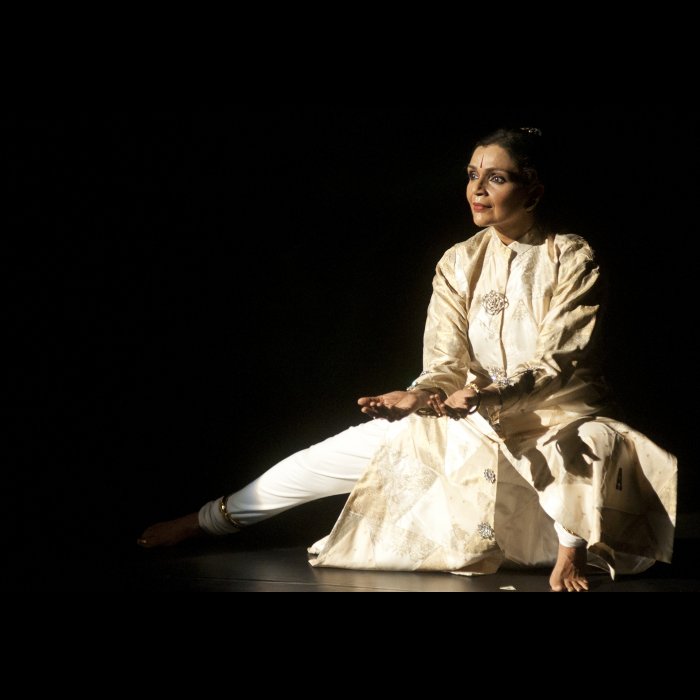
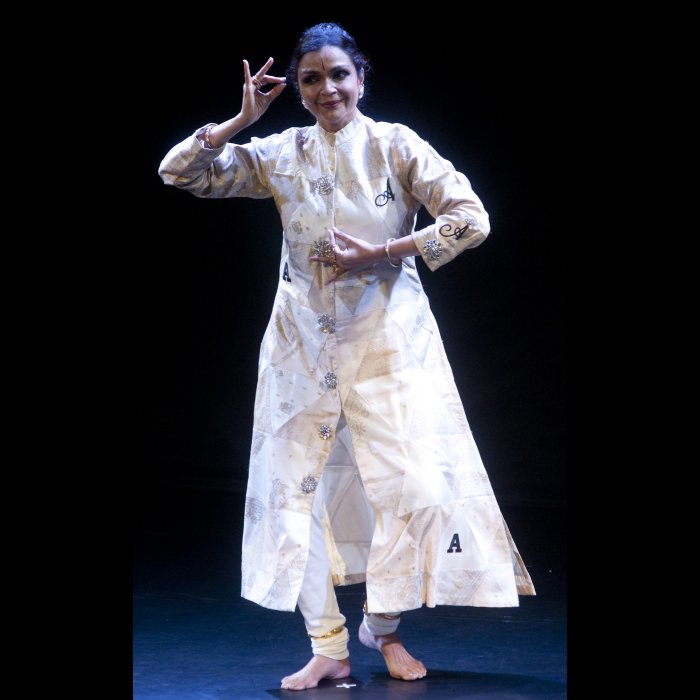

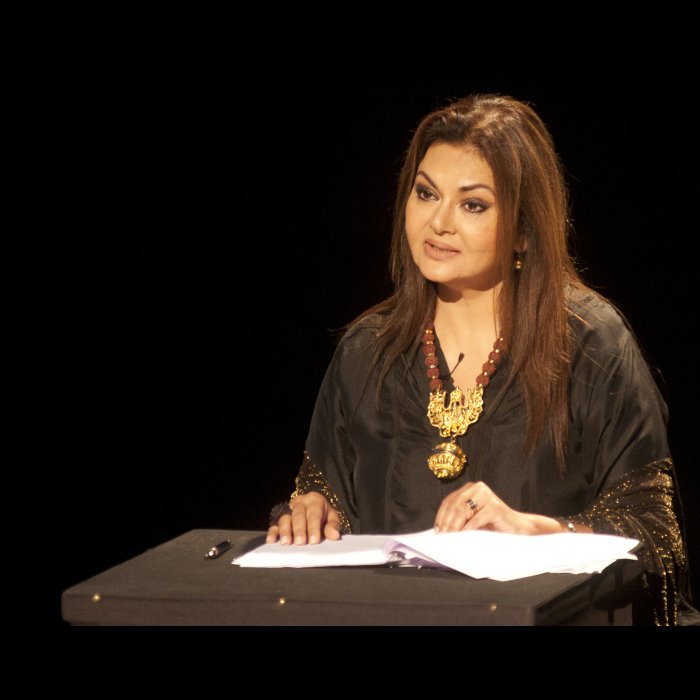 

 
 On 26th April, Anita Ratnam from Chennai presented 'Circles of Love: Dance, Poetry, And...' with Mumbai based poet Malavika Sangghvi, and Chennai based musician Vedantam Bhardwaj, with Victor Paulraj's dramatic lighting. Anita and Sandhya Raman designed the costumes. An excellent teamwork that stood out for its novel approach and coming together of gifted artists from different disciplines for a dance theatre. Years ago, I had seen Anita's 'Daughters of the Ocean' and was most impressed by her delivering dialogues like a seasoned actor. With a commanding stage presence, Anita performs with ease her basic Bharatanatyam along with movements she liberally draws from Kathakali, Mohiniattam, Kalaripayattu and Tai Chi etc. Drawn from personal memoir and real life anecdotes, metamorphosing into artistic expression, universalizing emotions, Anita illuminated the multiple dimensions of motherhood: woman as daughter, parent, sibling and juicy crony elder. Since past forty years, I have known Anita and her sister Pritha, their mother Lilly (Leelavati), grandmother Saraswati and also her children, so for me it was a pleasure to watch how Anita was able to take off from personal life experiences and weave a myriad of images, using vachikabhinaya and even singing ,moving confidently on the stage. It was heartening to see Malavika Sangghvi, the poet and author, reciting well-chosen English poems which Malavika rendered with great feeling and diction. Being a Mumbaikar, having known Malavika, I felt very emotional and lost my sense of objectivity as a critic. But seeing her after nearly two decades, I realized how mature she is now, and makes poems come alive. Poems of Nissim Ezekiel, her own, Anita Ratnam, Jane Ferrer, Lorna Goodison, Sri Aurobindo, translations by A. K. Ramanujam of Sangam poems - they evoked resonances of motherhood in its various ramifications. Anita and Malavika had together chosen these poems which spoke volumes for their endeavour to invest the production with high literary content. Anita also chose lullabies with care. From 1961 Tamil mega hit film 'Pasa Malar' starring Shivaji Ganesan and Savitri (it was remade in Hindi with Ashok Kumar and Waheeda Rehman) the iconic lullaby "Malarnthum malarada paadi malar pola" though culture specific had mesmerising effect as were lamentations of death from play and film 'Rudali.' Vedant Bhardwaj's singing Meera's song had the audience wanting him to sing more. His strumming of guitar, subtle touches of other musical instruments to the rendering of Malavika's poems created exquisite background music. Anita spoke of Devaki remembering Krishna who was sent away to Yashoda, recalling how he danced on hood of serpent Kaliya, how he lifted the mount Govardhan with his little finger, played Raas with milkmaids, encouraged Arjuna to fight in battlefield as his duty, showing him Vishwarupa. She enacted all these subtly sitting on the floor, as Devaki recalling, to the musical score of Kannada song "Krishna ni begane baro" melodiously composed, rendered in Yaman Kalyan raga traditionally by Anil Srinivasan. Without vocals, and to mere instrumental sound, it had a mesmerizing impact. Anita's abhinaya to it was subtle with minimal economic gestures. There were other quotations, Maria Callas's 'Ave Maria' like chants, Rudali's heart wrenching 'marasiyas'- lamentations, visuals when Anita holding red cloth turns it into a child and places it in hands of Malavika, her head covered with black cloth with effective lighting by Victor. When Anita showed rituals of washing hands and feet, light fell only on her palms and wrists, her feet and then on her face before fading away. Then with a mischievous smile in a different costume, Anita brought a touch of humour describing various types of mothers: angry mothers, single mothers, possessive mothers, and ending with "Mere pas Maa hai" which audience lapped up- who would not remember that dialogue by Shashi Kapoor? The finale with Anita carrying an earthen pot full of rice and turning it over, emptying rice, placing pot upturned and showering rice on it, placing it on all sides, reiterating rice as a symbol of fertility connecting with mother and lights gently fade. The final poem," Daughter: I cannot fathom/the depth of you/....I already see the woman deep inside you...My own wisdom already seems limited/What have I to offer/ You who have so many answers/am sure you will teach me/I have so much to learn....." was very touching. Anita's niece Shai joined in the Q and A session in place of Anita's daughter Arya. The other generation was presented by the niece, who had studied dance for a decade, but does not want to take to dancing. She frankly made the statement that some daughters do not necessarily want to follow mother's footsteps and be dancers. They admire mother's dance, but do not want to dance. They have different aspirations. Shai is an MBA, studied in New York, has chosen her own life partner and wants to lead her own life. Mothers who are dancers also face such situations, where even if they want their daughters to learn and perform dance, the daughters do not want to be dancers. I remember in most cases, most of the dancers who are my contemporaries and whose dance performances I have reviewed over past forty and more years, their mothers were not allowed to dance. Therefore they found their wish fulfilled in their daughters becoming dancers. Those were different times and there were social prejudices. Now times have changed, so issues are different. NCPA presented a complex theme in an interesting and engaging manner. I could not see Sujata Mohapatra and her daughter Preetisha's 'Sangachhdhwam' (walking on the same path together) in Odissi. I had seen them performing together for the first time two years ago at Guwahati. Preetisha is a brilliant dancer; dance is in her blood, being the granddaughter of Guru Kelucharan Mohapatra, daughter of Ratikant Mohapatra and Sujata, both dancers who are carrying on the precious legacy of Guruji. Swapnokalpa moderated the Q and A. She is an Odissi dancer and am sure the evening must have been memorable. What could be more appropriate than when Ratikant played mardala and Sujata and Preetisha peformed. Such artistic confluence - sangam- is rare. During the Mudra dance festival week, there were also workshops in Odissi by Sujata Mohapatra with a record number of more than 20 dancers including five from overseas. I attended one session, when Sujata was teaching Braj ku chor ashichhi, that wonderful lullaby Kelubabu choreographed on Kum Kum Mohanty. And lucky as I am, I was present then watching those choreographic sessions. Today Guruji's legacy is being transferred to young dancers by Sujata as Guruji taught her. Those who had registered for workshop had basic and considerable knowledge of Odissi. Swapnokalpa and all participating dancers, who gave their best conceiving, performing , discussing on theme of motherhood, deserve unreserved congratulations. I am glad I could attend the festival in Mumbai and see for myself how Mumbaikars thronged the theatre, enjoyed and supported the festival, and buying tickets, unlike what I see in Delhi where dance is not treated with such respect. A pity!  Dr. Sunil Kothari is a dance historian, scholar, author and a renowned dance critic. He is Vice President of World Dance Alliance Asia Pacific India chapter, based in New Delhi. He is honored by the President of India with Padma Shri, Sangeet Natak Akademi award and Senior Critic Award from Dance Critics Association, NYC. He is a regular contributor to www.narthaki.com, the roving critic for monthly magazine Sruti and is a contributing editor of Nartanam for the past 12 years. Post your comments Pl provide your name and email id along with your comment. All appropriate comments posted with name and email id in the blog will also be featured in the site. |